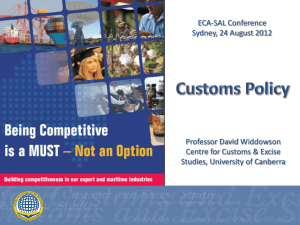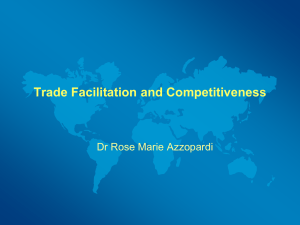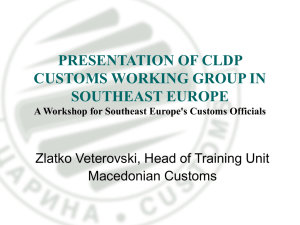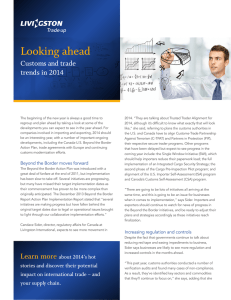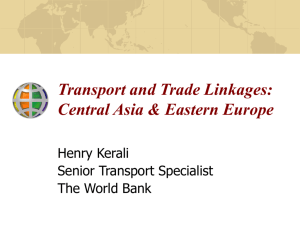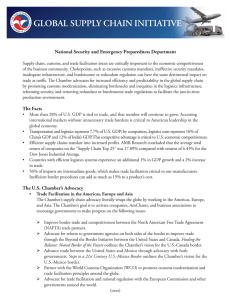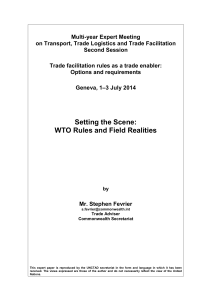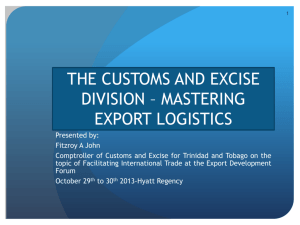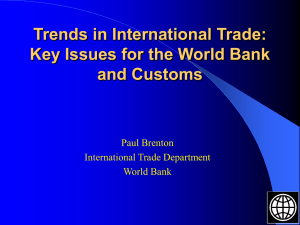crown agents
advertisement
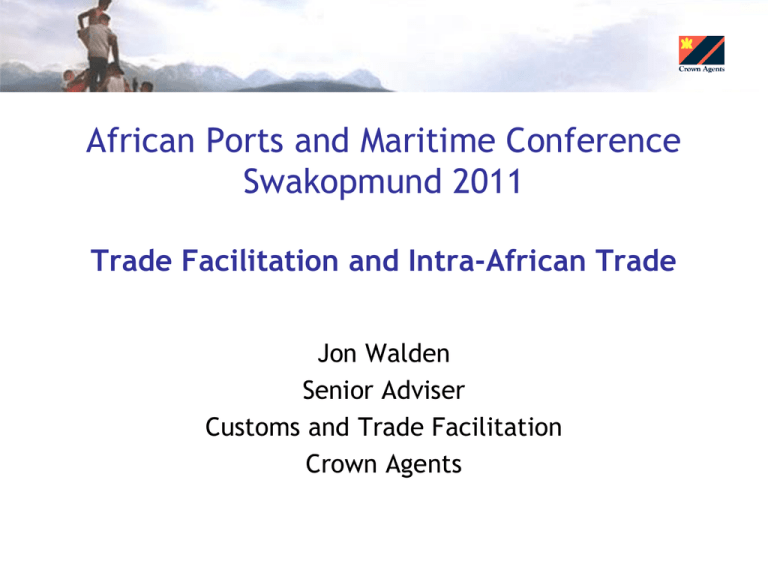
African Ports and Maritime Conference Swakopmund 2011 Trade Facilitation and Intra-African Trade Jon Walden Senior Adviser Customs and Trade Facilitation Crown Agents The current international trade environment involves complex international trade processes with disparate systems Each international trade transaction requires an average of 40 documents of 200 data elements, with 15% repeated at least 30 times and 60-70% repeated more than once. (UNCTAD) International Trade Supply Chain CROWN AGENTS “4P” APPROACH Crown Agents’ adopts a “4P” approach to implementing Trade Facilitative measures: Focusing People Improving Processes Implementing Platform Aligning Policy Typical cost elements in an international sale: The product Packing and handling Inland transport International transport / port charges / dwell time Insurance Documentation Customs clearance – export and import Security clearance – export and import Duties and taxes The Transport Issues Transport infrastructure – congested ports, road, rail, air Lack of competition Inter-modal capabilities – containerisation where appropriate High transport costs – land locked countries Need for common standards (axle weights, height etc) Availability and capacity of suitable haulage – chilled units / ventilated units Security (personnel and cargo) Availability of appropriate warehousing Import / export imbalance UNESCAP Time/Cost-Distance Model Need to identify – isolate – address bottlenecks Sea Transport Methodology for international route analysis Wait at sea port Transport to sea port Border crossing Time/ cost Transport to border Distance The Trade Issues – Non-tariff Barriers Lack of uniform procedures / processes - inconsistency Lack of standard documentation Lack of trading capacity / experience Customs delays Bureaucracy Few economies of scale Phyto-sanitary requirements Market access (tariff and non-tariff) I. The WCO approach to Capacity Building CB Committee: Special emphasis on the Millennium Development Goals (keynote speech by Helen Clark, UNDP) > Customs reform and modernization is a major driver of sustainable development and a key part of efforts to improve economic development and reduce poverty Copyright © WCO-OMD 2010 9 The Solutions Regional integration Harmonised legislation Institutional strengthening Trade / maritime Corridors – fed by, and feeding, efficient ports Information support networks / Trade partnerships / Innovation Trusted Trader regimes (competitive advantage?) One Stop Border Posts / Collaborative Border Management Holistic capacity building programmes Intermodal Transport Infrastructure Investment – private sector engagement / PPPs / stakeholder co-operation Reduce bureaucracy – IT / Single Window Environment ‘A Model corridor’ UNCTAD Corridor : Walvis Bay – Lusaka Landlocked country: Zambia Transit country: Namibia Clusters locations: Walvis Bay Port Border area Lusaka Regional Counterpart: Walvis Bay Corridor Group Transport Example The new….. Transport policy reform Increase financial transparency, accountability and viability Enterprise autonomy Resource cost-effectiveness Logistic planning / return loads Enhanced transport service delivery The Transport Challenge! “The challenge is to develop a deregulated and privatised multi‐modal transportation and logistics system responsive to the trader’s and economy's needs and user expectations.” Also, let’s exploit: ICT / Single Window Concept Trade / maritime Corridors Beneficial contracting Collaborative border management Customs modernisation – ‘facilitate legitimate trade’ Transport liberalisation, and A holistic approach to trade facilitation and subsequent increased competitiveness Crown Agents Customs and Trade Facilitation THANK YOU www.crownagents.com/customs jon.walden@crownagents.co.uk

